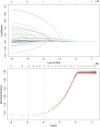The correlation between albumin-corrected anion gap and prognosis in patients with acute myocardial infarction
- PMID: 38164072
- PMCID: PMC10966208
- DOI: 10.1002/ehf2.14639
The correlation between albumin-corrected anion gap and prognosis in patients with acute myocardial infarction
Abstract
Aims: Acute myocardial infarction (AMI) is a cardiovascular disease with high morbidity and mortality. We collected patients with AMI from the Medical Information Mart for Intensive Care IV (v2.0) database and explored the association between serum albumin-corrected anion gap (ACAG) level and mortality in patients with AMI.
Methods and results: Data of adult patients with AMI were collected. According to the 360 day prognosis, patients were divided into survival and non-survival groups. Based on the ACAG level, patients were then divided into normal and high ACAG groups. Cox hazard proportional models and restricted cubic splines (RCSs) were used to investigate the correlation between ACAG and mortality. Kaplan-Meier curves were created to compare the cumulative survival rates between the high and normal ACAG groups. The receiver operating characteristic (ROC) curve was used to analyse the predictive value of ACAG for the prognosis of patients with AMI. Sensitivity and subgroup analyses were conducted to revalidate the results. Finally, 1783 patients were included. Elevated ACAG (>20 mmol/L) was significantly associated with 30 and 360 day mortality (P < 0.001). Adjusted for multiple confounding factors, the Cox proportional hazard analysis showed that elevated ACAG (>20 mmol/L) was an independent risk factor of increased all-cause mortality in patients with AMI (hazard ratio 1.423, 95% confidence interval 1.206-1.678, P < 0.001). RCS analysis further showed that there was a non-linear trend relationship between ACAG and the risk of all-cause mortality at 30 and 360 days (χ2 = 10.750, P = 0.013; χ2 = 13.960, P = 0.003). Kaplan-Meier survival curves showed that the 30 and 360 day cumulative survival rates of patients with AMI were significantly lower (log-rank test, χ2 = 98.880, P < 0.001; χ2 = 105.440, P < 0.001) in the high ACAG group. ROC curve analysis showed that the area under the curve (AUC) of ACAG was 0.651, while the AUC of anion gap (AG) was 0.609, indicating that ACAG had a higher predictive value for 360 day mortality than AG. When combined with Sequential Organ Failure Assessment score, the predictive performance of ACAG for 360 day mortality was better, with an AUC of 0.699. Sensitivity and subgroup analyses were conducted suggesting the stability of our results.
Conclusions: Elevated serum ACAG (≥20 mmol/L) is an independent risk factor for short-term and long-term mortality in critically ill patients with AMI, and it may assist clinicians and nurses identifying high-risk patients.
Keywords: Acute myocardial infarction; Albumin‐corrected anion gap; MIMIC‐IV; Mortality; Prognosis.
© 2024 The Authors. ESC Heart Failure published by John Wiley & Sons Ltd on behalf of European Society of Cardiology.
Conflict of interest statement
None declared.
Figures





Similar articles
-
Association between albumin corrected anion gap and 30-day all-cause mortality of critically ill patients with acute myocardial infarction: a retrospective analysis based on the MIMIC-IV database.BMC Cardiovasc Disord. 2023 Apr 28;23(1):211. doi: 10.1186/s12872-023-03200-3. BMC Cardiovasc Disord. 2023. PMID: 37118662 Free PMC article.
-
Albumin corrected anion gap and clinical outcomes in elderly patients with acute kidney injury caused or accompanied by sepsis: a MIMIC-IV retrospective study.Eur J Med Res. 2025 Jan 7;30(1):11. doi: 10.1186/s40001-024-02238-z. Eur J Med Res. 2025. PMID: 39773636 Free PMC article.
-
Association between albumin corrected anion gap and all-cause mortality in critically ill patients with acute kidney injury: a retrospective study based on MIMIC-IV database.Ren Fail. 2023;45(2):2282708. doi: 10.1080/0886022X.2023.2282708. Epub 2023 Nov 17. Ren Fail. 2023. PMID: 37975171 Free PMC article.
-
Albumin corrected anion gap for predicting in-hospital death among patients with acute myocardial infarction: A retrospective cohort study.Clinics (Sao Paulo). 2024 Jul 29;79:100455. doi: 10.1016/j.clinsp.2024.100455. eCollection 2024. Clinics (Sao Paulo). 2024. PMID: 39079461 Free PMC article.
-
Prognostic significance of albumin corrected anion gap in patients with acute pancreatitis: a novel perspective.Sci Rep. 2025 Jan 8;15(1):1318. doi: 10.1038/s41598-025-85773-x. Sci Rep. 2025. PMID: 39779808 Free PMC article.
Cited by
-
Association of albumin-corrected anion gap with severe consciousness disorders and outcomes in ischemic stroke: a retrospective MIMIC analysis.Sci Rep. 2024 Oct 29;14(1):26006. doi: 10.1038/s41598-024-76324-x. Sci Rep. 2024. PMID: 39472602 Free PMC article.
-
Increased serum albumin corrected anion gap levels are associated with poor prognosis in septic patients with liver cirrhosis.Sci Rep. 2024 Sep 14;14(1):21510. doi: 10.1038/s41598-024-72703-6. Sci Rep. 2024. PMID: 39277682 Free PMC article.
-
The association between Albumin-Corrected Anion Gap (ACAG) and the risk of acute kidney injury in patients with acute pancreatitis: A retrospective analysis based on the MIMIC-IV database.PLoS One. 2025 Aug 22;20(8):e0330458. doi: 10.1371/journal.pone.0330458. eCollection 2025. PLoS One. 2025. PMID: 40844993 Free PMC article.
-
Association of elevated albumin-corrected anion gap with all-cause mortality risk in atrial fibrillation: a retrospective study.BMC Cardiovasc Disord. 2025 Jan 27;25(1):55. doi: 10.1186/s12872-025-04518-w. BMC Cardiovasc Disord. 2025. PMID: 39871159 Free PMC article.
-
The prediction value of serum anion gap for short-term mortality in pulmonary hypertension patients with sepsis: a retrospective cohort study.Front Med (Lausanne). 2025 Jan 7;11:1499677. doi: 10.3389/fmed.2024.1499677. eCollection 2024. Front Med (Lausanne). 2025. PMID: 39839613 Free PMC article.
References
-
- Ismail SR, Mohammad MSF, Butterworth AS, Chowdhury R, Danesh J, di Angelantonio E, et al. Risk factors of secondary cardiovascular events in a multi‐ethnic Asian population with acute myocardial infarction: A retrospective cohort study from Malaysia. J Cardiovasc Dev Dis 2023;10:10. doi:10.3390/jcdd10060250 - DOI - PMC - PubMed
MeSH terms
Substances
Grants and funding
LinkOut - more resources
Full Text Sources
Medical
Miscellaneous

